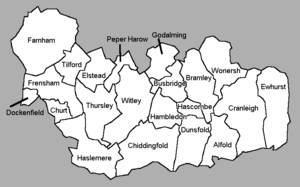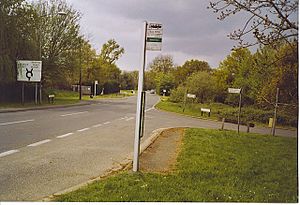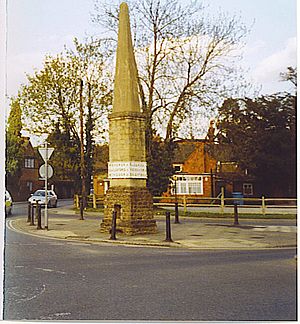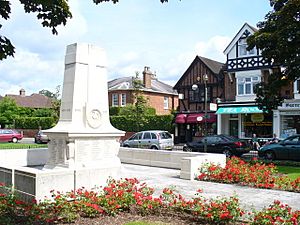Cranleigh facts for kids
Quick facts for kids Cranleigh |
|
|---|---|
| Village | |
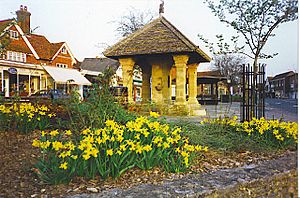 Cranleigh High Street |
|
 Arms of Cranleigh |
|
| Area | 32.78 km2 (12.66 sq mi) |
| Population | 11,241 (Civil Parish 2011) |
| • Density | 343/km2 (890/sq mi) |
| OS grid reference | TQ065385 |
| Civil parish |
|
| District | |
| Shire county | |
| Region | |
| Country | England |
| Sovereign state | United Kingdom |
| Post town | CRANLEIGH |
| Postcode district | GU6 |
| Dialling code | 01483 |
| Police | Surrey |
| Fire | Surrey |
| Ambulance | South East Coast |
| EU Parliament | South East England |
| UK Parliament |
|
| Arms of Cranleigh Parish Council | |
|---|---|
 |
|
| Crest | On a Wreath of the Colours two Cranes reguardant respectant each resting the interior leg on a Basket Or. |
| Blazon | Or on the Chevron Azure between three Maple Leaves Gules three Bezant a Chief chequy of the first and second fimbriated Gules. |
| Motto | Cranleigh Habet Caritatem ("Cranleigh cares") |
| Granted 10 January 2007 | |
Cranleigh is a village and civil parish, about 8 miles (13 km) southeast of Guildford in Surrey, England. It lies on a minor road east of the A281, which links Guildford with Horsham. It is in the north-west corner of the Weald, a large remnant forest, the main local remnant being Winterfold Forest directly north-west on the northern Greensand Ridge.
Contents
History
Etymology
Until the mid-1860s, the village was usually spelt Cranley. The Post Office succeeded in getting the spelling changed to avoid confusion with nearby Crawley in West Sussex. The older spelling is preserved by the Cranley Hotel in the middle of the village. The origin of the name is recorded in the Pipe Rolls as both Cranlea in 1166 and Cranelega in 1167. A little later in the Feet of Fines of 1198 the name is written as Cranele. Etymologists consider all these versions to be the fusion of the Old English words "Cran", meaning "crane", and "Lēoh" that together mean 'a woodland clearing visited by cranes'. The name is popularly believed to come from the large crane breeding grounds that were supposed to have been historically located at Vachery Pond, locally known as simply Vachery. The figure of a crane adorns the old drinking water fountain of 1874 which can still be found in the middle of the village in 'Fountain Square', and a pair of cranes adorn the crest of the recently granted civic Coat of arms of Cranleigh Parish Council.
Early History
Situated partly on the Greensand Ridge, where it rises to 700 feet (210 m) at Winterfold Hill, but mainly on the clay and sandstone Lower Weald, Cranleigh has little of prehistoric or Roman interest, whereas just across the east border Wykehurst and Rapley Farms have a Roman buildings and Roman Tile Kilns — in the parish of Ewhurst. A spur of the Roman road between London and Chichester runs north west to Guildford past nearby Farley Heath in Farley Green, a temple site. Cranleigh was not mentioned in the Domesday Book, at that time being part of the manor of Shere.
The Anglican parish church of St Nicolas dates the first building on its site from around 1170, and the building was in its present form by the mid-14th century. It was extensively restored in 1847. The church has a gargoyle, situated on a pillar inside the church, which is said to have inspired Lewis Carroll, who lived in Guildford, to create the Cheshire Cat. With the growth of the village, a "daughter" church, St Andrew's, opened at the west end of the village in 1900 but it closed some sixty years later. The parish is in the Diocese of Guildford.
Oliver Cromwell visited Knowle in 1657, his soldiers being billeted in houses in the village.
Post Industrial Revolution
Growth came due to improvements in transport; in 1813 the Wey and Arun Canal was authorised. Three years later it opened, passing a few miles to the west of the village. This route linked London (via the Thames and the Wey) with Littlehampton (via the Arun). However, the canal traffic was completely eclipsed by the Horsham to Guildford railway which opened in 1865, and the canal fell into disuse. A turnpike road was also built between Guildford and Horsham, assent for the project being given in 1818. The opening is commemorated by an obelisk at the junction of the roads to Horsham and to Ewhurst. The Prince Regent used the route when travelling between Windsor and Brighton, the distances to which are given on the plaque on the obelisk.
Cranleigh railway station was closed by Dr Beeching in 1965 after almost exactly a hundred years of operation.
Three people played a major part in the development of the village during the nineteenth century: Reverend John Henry Sapte, Doctor Albert Napper and Stephen Rowland. Sapte arrived in Cranleigh in 1846 as the rector. He played a major role in setting up the National School in 1847 and Cranleigh School in 1865. He remained in the village until his death in 1906, by this time having been appointed Archdeacon of Surrey.
Together with Napper, Sapte set up the first cottage hospital in the country in 1859. It has survived many attempts to close it, through fundraising by the local community. However it lost its beds for in-patients in May 2006.
Stephen Rowland was a resident who had a major role in the development of the infrastructure of the village. He formed the Cranleigh Gas Company in 1876, and arranged for a mains water supply in 1886. In 1894 he laid out an estate between the Horsham and Ewhurst Roads, building New Park Road, Avenue Road, Mead Road, Mount Road and Bridge Road. He also set up a grocery store. His name is commemorated in that of Rowland Road.
During World War II, on 27 August 1944, the infant school was hit by a V-1 flying bomb and demolished. This occurred early on a Sunday morning, and the school was empty. The only casualty was the Rector, who was in his garden not far away and was injured. Another flying bomb hit the gasholder on the Common, destroying both the structure and a nearby cottage, whose occupant was killed.
The Regal Cinema opened on 30 October 1936. It survived for over sixty years, finally closing on 14 March 2002. The site is now occupied by a block of flats.
The cricket field has been used for that purpose since 1843. Cranleigh Lawn Tennis Tournament was held there in August from 1922 until 1998, when it moved to the grounds of Cranleigh School.
David Mann's department store opened in 1887 and is still in business.
In 1975 the 1900-built church of St Andrew was demolished. A distinctive row of maple trees which lines the High Street between the cricket field and the Rowland Road junction was planted in 1890, and not by Canadian servicemen in World War I as is widely believed.
Cranleigh's Village Hall opened in 1933. The village lays claim to be the largest village in England.
Geography
Cranleigh village is 7.7 miles (12.4 km) southeast of the county town of Surrey, Guildford, and 6.2 miles (10.0 km) ESE of Godalming, which is the administrative centre of the borough of Waverley. In the centre of the civil parish are the greatest number of buildings, fanning out in many side roads and situated on the high street itself. Cranleigh Waters also known as the Cranleigh Water drains the village, before flowing to Shalford where it joins the River Wey, specifically in the small, formerly marsh-like locality of Peasmarsh, which still has water meadows lining the bank itself. Winterfold Forest, a remaining higher part of the forest that occupies the northeast is on the Greensand Ridge, which can be explored using in places roads or by the long distance path, the Greensand Way.
 |
Bramley | Shamley Green, Wonersh | across Winterfold Forest Shere |
 |
| Hascombe | Ewhurst | |||
| Alfold | Rudgwick | Ewhurst (part of) |
Elevations, Soil and Geology
Elevations range from a maximum of 240m AOD at the car park on Reynolds Hill in Winterfold Heath (a woodland in the north) to 41m on the watercourse and Wey and Arun Canal (disused) as they leave both the parish in the northwest extreme at the end of East Whipley Lane. Its village centre lies at generally 50—70m above mean high water sea level (AOD).
Soil consists in small areas of "naturally wet loamy soil"; the north and south of the village centre and all surrounding areas are "slowly permeable seasonally wet slightly acid but base-rich loamy and clayey soils".
Then deep seas, Gault Clay and the Upper Greensand deposits form the deep soil, more evident where erosion has taken place on steeper hillslopes in the civil parish. The Gault Clay contains phosphate-rich nodules in discrete bands and has a rich marine fauna with abundant ammonites, bivalves and gastropods. The Upper Greensand comprises a variety of sediments with fine silts at the base giving way upwards into sandstones. Just before the paleogene which included the mass-extinction event of the non-avian dinosaurs sea levels dropped, exposing Sussex and Kent, marine Upnor Beds were deposited in Surrey. In the paleogene, Southern England slightly rose and the seas retreated and reddish and mottled clays of the Reading Beds were deposited by a large river sand delta system including across much of the Weald (which covers much of Sussex and Kent as well). Later, a rise in sea level, around 50 million years ago caused widespread deposition, until 2 million years ago, of the London Clay across the county. The London Clay is a bluish-grey marine clay with isolated pockets of fossils especially where chalkier. The youngest part of the London Clay is known as the Claygate Beds and sand and soft sandstone of the Bagshot Formation, though in many areas such as this generally eroded, followed in most cases by a variable thickness of organic humus.
Recreation and entertainment
The Cranleigh Arts Centre runs a full programme of feature film screenings, live music, theatre productions, adult and children's activities, exhibitions and workshops. Regular community arts projects and work with local schools are undertaken to reach and develop new audiences. The Centre is a registered charity and is run by a team of volunteers.
The village has a relatively large public library. Every year the Cranleigh & South Eastern Agricultural Society hold the Cranleigh Show, which is a traditional agricultural show. A gym and leisure centre (which incorporates an indoor swimming pool) is located centrally just off the High Street.
Cranleigh has a football club, Cranleigh F.C., who play in the Surrey Elite West Division having formerly been members of the Combined Counties League. Cranleigh has a Sports and Social Club which hosts a bowls club and pétanque clubs.
Localities
Rowly
Rowly is a neighbourhood 0.8 miles (1.3 km) NNW of the edge of the contiguous suburban part of Cranleigh that architecturally contains three Grade II listed buildings.
Three surrounding farms have listed farmhouses, and one of these has a listed granary.
Rowly is separated from Cranleigh by Manfield Park and Hollyhocks House.
Baynards
Baynards to the south is separated by a green buffer including the lake, Vachery Pond. It consists of fewer than 20 buildings. Reached by Knowle Lane, a rural road leading off of the high street, which is dotted with houses, the settlement lies east of that lane along another lane, Baynards Road. No other neighbourhoods or localities of importance exist in the civil parish as a whole.
Religion
There is a Roman Catholic church, Jesus Christ Redeemer of Mankind (in the Roman Catholic Diocese of Arundel & Brighton), and churches of the Methodist and Baptist denominations, as well as the Anglican church of St Nicolas mentioned above.
Transport
Rail
Cranleigh railway station was opened in 1865 as "Cranley" as part of the Cranleigh Line, its name was changed in 1867 to "Cranleigh" at the request of the Postmaster General as badly addressed letters to "Cranley" were often mistaken for "Crawley" and vice versa. Cranleigh was the busiest station on the line with regular commuter traffic to and from London via Guildford. Cranleigh had a substantial goods yard equipped with a large loading gantry. Inward freight consisted mainly of coal which was required, in particular, by the local gasworks, whilst goods outward were mainly timber.
A victim of the Beeching Axe, the line closed in 1965 and Cranleigh station was demolished shortly afterwards, replaced by the "Stocklund Square" housing and shopping development. In 2004 part of this development was itself demolished and a Sainsbury's supermarket was constructed on the site. Today the trackbed is in part used by the Downs Link, and the station's old platform levels are still visible at the rear of the shops.
Two studies have been carried out to review the possibility of reviving train services. The first, in the 1990s, was to determine whether re-opening a portion of the line for passenger traffic from Bramley to Guildford would be economically viable. Although the study was inconclusive, Waverley Borough Council protected the line from further development in its Local Plan. In 2009, the Association of Train Operating Companies applied for funding for a new line to Cranleigh.
Road
Cranleigh centres around the junction of two B roads to the east of the A281 Guildford to Horsham road.
The village is on a number of bus routes serving, among others, Guildford, Horsham, Godalming and Ewhurst. The main operator is Stagecoach.
Tillingbourne Bus Company was based in the village prior to its collapse in 2001.
Canal
The Wey and Arun Canal is gradually being restored.
Landmarks
Stocklund Square
A square near the centre of the village on the High Street, which is the main road running through Cranleigh. Stocklund Square was constructed following the closing of the railway line in 1965, and the removal of the railway station.
A new Sainsbury's supermarket was built in late 2004. Other shops in the square are Oxfam, Carphone Warehouse and Costa Coffee. The square used to have greenery and a fountain, but this was replaced with a more open layout that now accommodates local attractions and events such as an Easter Service and a French Market.
Fountain Square
In 2006, the pedestrian area surrounding the large stone drinking fountain monument (1874) at the centre of the village was re-modelled, and given the name 'Fountain Square'. New granite paving, brick planters and trees were introduced in a design which created a haven from traffic and a new focal point for community events. During the refurbishments the old "threepenny bit" bus shelter was moved to Snoxhall behind the leisure centre. The old "threepenny bit" bus shelter had been a popular shelter for the youths of Cranleigh to drink and smoke in. The shelter stood in its new location for only a few weeks before it was vandalised and completely pulled to the ground. The main financial sponsors of this refurbishment were Surrey County Council (SCC) and the South East England Development Agency (SEEDA), and the design was undertaken in-house by SCC.
Winterfold House
Winterfold House, north-east of the village along Barhatch Lane, was built in 1886 for Richard Webster QC, afterwards Viscount Alverstone. He became Lord Chief Justice in 1900 and died in 1915. A bench in the woodland above the house is known as 'Lord Justice Seat'.
The house was then bought by Charles Armytage-Moore, founder partner in the stockbrokers Buckmaster & Moore. He reconstructed the main facade in Queen Anne style, and enhanced the gardens with rare rhododendrons, camellias, azaleas and magnolias. One particular red-flowered species (Rhododendron barbatum Wallich ex G. Don 1834) won an Award of Merit when exhibited by Winterfold House in 1934. During World War II Winterfold was requisitioned by the Government and used by SOE Special Operations Executive as a training school designated STS 4. Amongst the many recruits that attended Winterfold included Violette Szabo GC.
Armytage-Moore died in 1960. The house was sold to HRH Prince Carol of Romania and it achieved notoriety by being searched for evidence after the Great Train Robbery of 1963. Nothing was found. The house and estate of 212 acres (0.86 km2) was sold in 18 lots at auction in 1978.
In popular culture
Cranleigh appears in the book The Meaning of Liff by Douglas Adams and John Lloyd, in which experiences which do not have words yet are given words which currently only exist as names of places. "Cranleigh" is defined as: "A mood of irrational irritation with everyone and everything."
"Cranleigh Hall", the home of "Lord Cranleigh", was the principal location for the Doctor Who serial, Black Orchid.
Demography and housing
| Output area | Detached | Semi-detached | Terraced | Flats and apartments | Caravans/temporary/mobile homes | shared between households |
|---|---|---|---|---|---|---|
| (Civil Parish) | 2,089 | 1,137 | 667 | 881 | 5 | 0 |
The average level of accommodation in the region composed of detached houses was 28%, the average that was apartments was 22.6%.
| Output area | Population | Households | % Owned outright | % Owned with a loan | hectares |
|---|---|---|---|---|---|
| (Civil Parish) | 11,492 | 4,779 | 43.3% | 32.2% | 3,278 |
The proportion of households in the civil parish who owned their home outright compares to the regional average of 35.1%. The proportion who owned their home with a loan compares to the regional average of 32.5%. The remaining % is made up of rented dwellings (plus a negligible % of households living rent-free).
Economy, twinning etc.
Despite losing the rail link, Cranleigh has prospered both as a satellite of Guildford, and as a service and light engineering centre in its own right. Furthermore, it is a retail centre for the surrounding smaller villages. The resident population of the area decreased by 2.0% in the ten years to 2001. In January 2007, Cranleigh Parish Council received a grant of arms. Cranleigh is twinned with Vallendar, Germany, and with Semur-en-Auxois in Burgundy, eastern France. Cranley Hotel is in a large Victorian house which is a listed building. Nurseries for plant for sale and food provide a significant source of local employment.
Cranleigh's High Street has seen a rise in large corporate shops in recent years, such as Co-op, Peacocks, Superdrug, and WH Smith. There are three supermarkets and two national banks, and various other shops.
Education
Cranleigh School, an independent boarding school, is in the village. It opened in 1865 and was originally known as "The Surrey County School".
State schools include Glebelands School (a secondary school), Cranleigh C of E Primary School and Park Mead Primary School. There is also St Cuthbert Mayne Catholic Primary School. Cranleigh C of E Primary School opened in September 2008 as an amalgamation of Cranleigh Infants School and St. Nicolas Junior School.
In 1847 the National School opened in the present Arts Centre, replacing earlier dame schools. During the twentieth century, separate infant and secondary schools were formed and moved to their own premises (leaving the C of E Junior School which moved to new buildings in 1964).
Notable residents
- Sky News presenter Anna Botting was born and raised in Cranleigh.
- The artist Joseph Longhurst moved to Cranleigh in 1918, and lived there until his death in 1922. He was one of a group of artists who lived in the village in the early 1920s, including W. Heath Robinson and Lawson Wood.
- Mathematician G. H. Hardy was born and raised in Cranleigh.
- Frederick Savage, schoolmaster who founded Seaford College
- Jim Slater, accountant turned businessman, founder of Slater Walker, lived in the village
- Former drummer in The Beatles Ringo Starr and his actress wife Barbara Bach lived on the outskirts of the village.
- Frank Swinnerton the writer lived in the large cottage Old Tokefield on The Commons in Cranleigh for more than fifty years.
- Desmond Tutu, when serving as a curate in England in 1963, lived in the village for a month. He wrote in the parish magazine about how friendly the locals had been towards himself and his family.
See also
 In Spanish: Cranleigh para niños
In Spanish: Cranleigh para niños



